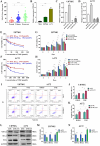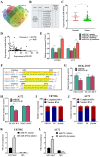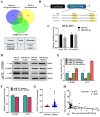Inhibiting lncRNA NEAT1 Increases Glioblastoma Response to TMZ by Reducing Connexin 43 Expression
- PMID: 39453684
- PMCID: PMC11505515
- DOI: 10.1002/cnr2.70031
Inhibiting lncRNA NEAT1 Increases Glioblastoma Response to TMZ by Reducing Connexin 43 Expression
Abstract
Objectives: Glioblastoma multiforme (GBM) is considered the most assailant subtype of gliomas, presenting a formidable obstacle because of its inherent resistance to temozolomide (TMZ). This study aimed to characterize the function of lncRNA NEAT1 in facilitating the advancement of gliomas.
Methods: The expression level of NEAT1 in glioma tissues and cells was detected by qRT-PCR. RNA interference experiment, cell proliferation assay, FITC/PI detection assay, immunoblotting, bioinformatics prediction, a double luciferase reporter gene assay, RNA immunoprecipitation (RIP) assay, SLDT assay and correlation analysis of clinical samples were performed to explore the regulatory effects of NEAT1, miR-454-3p and Cx43 and their role in malignant progression of GBM. The role of NEAT1 in vivo was investigated by an intracranial tumor formation experiment in mice.
Results: The results showed that recurring gliomas displayed elevated levels of NEAT1 compared to primary gliomas. The suppression of NEAT1 led to a restoration of sensitivity in GBM cells to TMZ. NEAT1 functioned as a competitive endogenous RNA against miR-454-3p. Connexin 43 was identified as a miR-454-3p target. NEAT1 was found to regulate gap junctional intercellular communication by modulating Connexin 43, thereby impacting the response of GBM cells to TMZ chemotherapy. Downregulation of NEAT1 resulted in enhanced chemosensitivity to TMZ and extended the survival of mice.
Conclusions: Overall, these results indicated that the NEAT1/miR-454-3p/Connexin 43 pathway influences GBM cell response to TMZ and could offer a potential new strategy for treating GBM.
Keywords: Connexin 43; NEAT1; chemotherapy sensitivity; miR‐454‐3p; temozolomide.
© 2024 The Author(s). Cancer Reports published by Wiley Periodicals LLC.
Conflict of interest statement
The authors declare no conflicts of interest.
Figures





Similar articles
-
miR-126-3p sensitizes glioblastoma cells to temozolomide by inactivating Wnt/β-catenin signaling via targeting SOX2.Life Sci. 2019 Jun 1;226:98-106. doi: 10.1016/j.lfs.2019.04.023. Epub 2019 Apr 10. Life Sci. 2019. PMID: 30980849
-
PDIA3P1 promotes Temozolomide resistance in glioblastoma by inhibiting C/EBPβ degradation to facilitate proneural-to-mesenchymal transition.J Exp Clin Cancer Res. 2022 Jul 15;41(1):223. doi: 10.1186/s13046-022-02431-0. J Exp Clin Cancer Res. 2022. PMID: 35836243 Free PMC article.
-
Exosomal transfer of long non-coding RNA SBF2-AS1 enhances chemoresistance to temozolomide in glioblastoma.J Exp Clin Cancer Res. 2019 Apr 16;38(1):166. doi: 10.1186/s13046-019-1139-6. J Exp Clin Cancer Res. 2019. PMID: 30992025 Free PMC article.
-
Role of Non-coding RNAs in the Response of Glioblastoma to Temozolomide.Mol Neurobiol. 2025 Feb;62(2):1726-1755. doi: 10.1007/s12035-024-04316-z. Epub 2024 Jul 18. Mol Neurobiol. 2025. PMID: 39023794 Review.
-
Regulated cell death modalities: breaking resistance of temozolomide glioblastoma therapy.Trends Cancer. 2025 May;11(5):430-432. doi: 10.1016/j.trecan.2025.01.007. Epub 2025 Feb 10. Trends Cancer. 2025. PMID: 39933982 Review.
Cited by
-
Molecular Interplay Between Non-Coding RNAs and Connexins and Its Possible Role in Cancer.Int J Mol Sci. 2025 Mar 12;26(6):2538. doi: 10.3390/ijms26062538. Int J Mol Sci. 2025. PMID: 40141179 Free PMC article. Review.
-
Long Non-Coding RNAs in Malignant Human Brain Tumors: Driving Forces Behind Progression and Therapy.Int J Mol Sci. 2025 Jan 15;26(2):694. doi: 10.3390/ijms26020694. Int J Mol Sci. 2025. PMID: 39859408 Free PMC article. Review.
-
Bibliometric analysis and visualization of Connexin 43 in the field of solid tumor research(2000-2024).Front Immunol. 2025 May 9;16:1588828. doi: 10.3389/fimmu.2025.1588828. eCollection 2025. Front Immunol. 2025. PMID: 40416989 Free PMC article.
References
-
- Kanderi T. and Gupta V., Glioblastoma Multiforme (Treasure Island, FL: StatPearls, 2024). - PubMed
MeSH terms
Substances
Grants and funding
- 2021GXNSFBA220024/Natural Science Foundation of Guangxi Province
- GUIKE AD22035055/Specific Research Project of Guangxi for Research Bases and Talents
- 202140240/The Clinical Research Project of Shanghai Municipal Health Commission
- GZxk-z-20-75/Guangxi traditional Chinese medicine key discipline construction project
LinkOut - more resources
Full Text Sources
Medical
Research Materials
Miscellaneous

